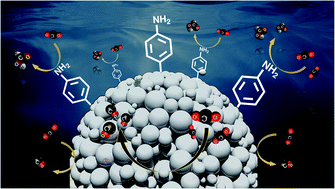Electrografting amines onto silver nanoparticle-modified electrodes for electroreduction of CO2 at low overpotential†
Abstract
Reducing carbon dioxide (CO2) to value-added synthons in a selective and efficient manner remains a sizable challenge to CO2 conversion research. Although many electrocatalysts have been reported to date, those with both high selectivity and high activity have continued to elude us. In this project, successful electroreduction of CO2 to carbon monoxide (CO) and formate was achieved at low overpotential through a facile and green one-step immobilization of p-phenylenediamine (PPD) onto a bare glassy carbon electrode (GCE) and a silver nanoparticle modified GCE surface (AgNPs/GCE). The faradaic efficiency (FE) and current density (j) of PPD were significantly improved from FE: 17% and j: −0.86 mA cm−2 to FE: 91% and j: −6.5 mA cm−2 after immobilizing PPD onto the AgNPs/GCE electrode support. The PPD–AgNPs/GCE system was observed to suppress the hydrogen evolution reaction and reduce CO2 to CO and formate with 4-fold more positive potentials (−0.2 V vs. RHE) in an alkaline environment. This work provides an effective strategy for the improvement of electrocatalytic performance which could inspire the future design of heterogeneous molecular catalysts for CO2 conversion and shines more light on the potential of electrografting onto a variety of electrode surfaces.



 Please wait while we load your content...
Please wait while we load your content...